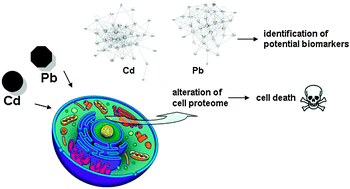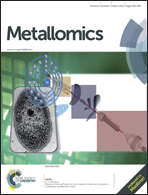A proteomic approach to investigate the effects of cadmium and lead on human primary renal cells†
Abstract
Heavy metals are extremely poisonous to the environment, but their impact on living cells and organisms is poorly understood at a molecular level. We investigated the effects of cadmium and lead on the viability of primary HRCE cells. A severe dose- and time-dependent inhibition of cell viability was induced by either heavy metal. Cell mortality was due to apoptotic death, as demonstrated by a decrease of procaspase-9 and down-regulation of the anti-apoptotic marker Bcl-2 with consequent activation of caspase-3. By ICP-MS analyses we determined the amount of heavy metals in the intracellular compartment, which was found to be higher for lead than cadmium. To gain insights into the effects of heavy metals on the cell proteome, a systematic investigation was performed, based on 2D-PAGE, image analysis, protein identification and bioinformatics analyses. Among more than 300 protein spots visualized in bidimensional maps, 27 proteins were found to be altered in their expression levels following heavy metal exposure. These proteins were all identified by nanoLC-MS/MS. The majority of them were found to be involved in apoptotic pathways, protein folding or energetic metabolism, which eventually lead to cell death. Taking advantage of an integrated workflow, we identified specific protein targets of heavy metals, which represent a contribution to the identification of potential biomarkers of heavy metal environmental pollution.


 Please wait while we load your content...
Please wait while we load your content...